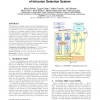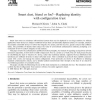708 search results - page 98 / 142 » On the Use of Word Networks to Mimicry Attack Detection |
ISMIS
2005
Springer
14 years 2 months ago
2005
Springer
Abstract. Anomaly detection is based on profiles that represent normal behaviour of users, hosts or networks and detects attacks as significant deviations from these profiles. In t...
ICAC
2009
IEEE
14 years 3 months ago
2009
IEEE
We present a mechanism for autonomous self-adaptation of a network-based intrusion detection system (IDS). The system is composed of a set of cooperating agents, each of which is ...
NOMS
2010
IEEE
13 years 7 months ago
2010
IEEE
—Malware and botnets pose a steady and growing threat to network security. Therefore, packet analysis systems examine network traffic to detect active botnets and spreading worm...
EUROSYS
2008
ACM
14 years 6 months ago
2008
ACM
Eudaemon is a technique that aims to blur the borders between protected and unprotected applications, and brings together honeypot technology and end-user intrusion detection and ...
CN
2004
13 years 8 months ago
2004
Smart dust motes are miniature self-contained systems that may be deployed in very large numbers. In military applications these devices are subject to different threats than conv...


